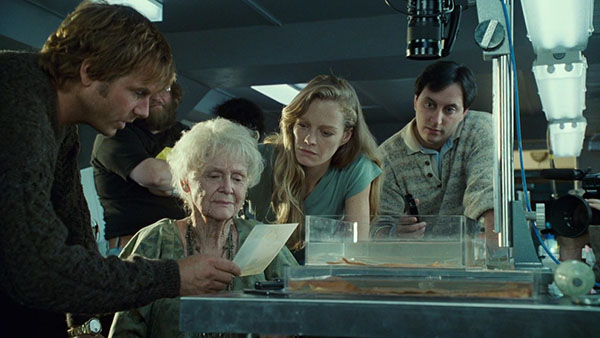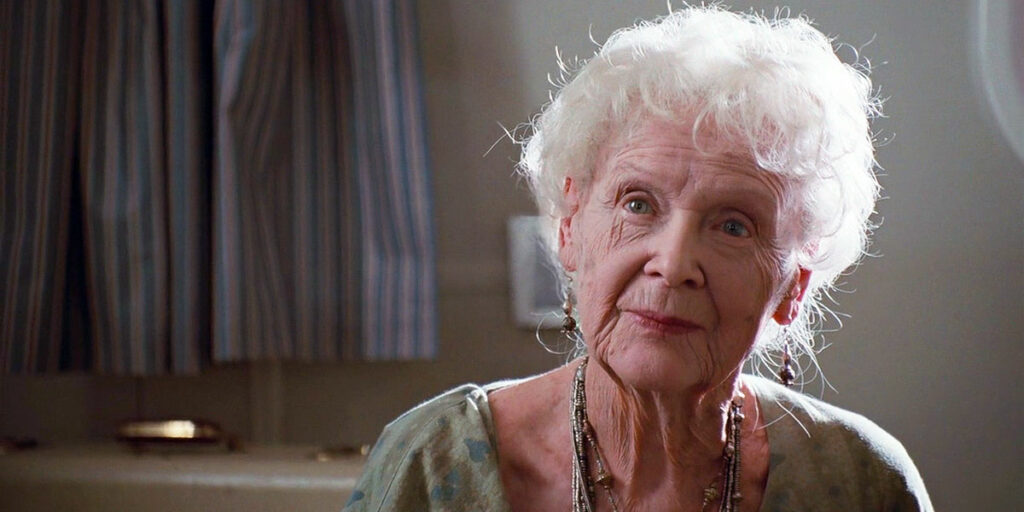Why is it important for Titanic ‘s story to be told from Old Rose ‘s point of view? Let’s take a look at the film’s narrative frame and how it improves the movie overall.
We’re all familiar with the “Old Rose” memes from Titanic: “It’s been 84 years…” *insert gif of white-haired woman with teary eyes*. But the 101 years old version of Rose Dewitt Bukater also serves a bigger purpose in James Cameron’s film, and is actually very important to the story; here’s why.
In celebration of its 25th anniversary, Titanic has just been re-released globally in theaters. But its gorgeous, immersive 3D 4K HDR visuals and high-frame rate weren’t the only thing that caught my attention when I watched the film on the big screen one more time, a few days ago. As I found myself back on the Titanic, I couldn’t help but think of how clever it was to use a narrative frame to introduce the main timeline of the movie.
Old Rose isn’t just there to remember her own story, but she serves a very specific purpose in the film. Her presence immediately gives away information that affects the way we experience the story itself, as well as adding more depth to her younger self and making the film more immersive by placing us right there and then, in 1996, as we, too, listen to her tale.
The film is based on the real-life story of the RMS Titanic in 1912, a luxury steamship that sank in 1912, leading to the deaths of more than 1,500 passengers. But the movie is actually set in 1996, when treasure hunter Brock Lovett (Bill Paxton) and his team are using advanced technology to explore a still sunken Titanic, looking for an incredibly valuable diamond called the Heart of the Ocean. What Lovett finds, instead, is the drawing of a woman wearing that exact same diamond, which leads to a phone call from Titanic ‘s protagonist, Rose Dewitt Bukater (Gloria Stuart) — only, she’s now 101 years old.
And so, Rose and her granddaughter are taken to Lovett’s boat, where the old lady tells the story of how, as a 17-year-old young woman (Kate Winslet), she boarded the Titanic in Southampton to become engaged to the arrogant but wealthy Cal Hockley (Billy Zane) and make her selfish, broke mother happy, but fell in love with a third class passenger named Jack Dawson (Leonardo DiCaprio) instead. Over the course of four days, Rose and Jack become very close, so much so that she decides to walk off the ship with him and call off her engagement, but the RMS Titanic sinks before they can make it to New York City. Jack dies, but Rose stays true to her promise to live her life to the fullest, holding on to her memories of the boy while building a new life for herself, away from the aristocracy.
By having the story take place in two timelines — first in 1996, when Rose is an old lady, and then in 1912, when she boards the Titanic as a teenager — the film employs a clever storytelling device while also giving away key information about our protagonist’s story before the story has even begun. “Old Rose” is more important than you think she is: here’s why.
AN IMMERSIVE STORY TOLD IN REAL TIME

The story of Titanic takes place in 1912, in a world that must have been unfamiliar to most filmgoers back in 1997. But writer-director James Cameron finds a way to immediately give us something to relate to: it’s 1996, and a treasure hunter is searching for a 56-carat diamond that just so happens to show up in a drawing, worn by a woman who’s also very much unclothed. As if that weren’t enough, an old lady enters the picture, claiming to be that woman, immediately making things more interesting.
If we went into the movie expecting a tragedy, Titanic immediately grips us with a story that’s not about death but about life, as the woman in front of us has clearly lived a great lot. It’s also a love story, which makes things even more interesting. We already know that the RMS Titanic sunk: what we don’t know is how young Rose ended up wearing the diamond a few hours before the disaster, what led her to pose naked for a drawing, and who drew it.
But that’s not all: as we listen to old Rose tell her story, we are not alone. Brock Lovett is not just a materialistic treasure hunter who redeems himself when he truly understands the scale of the Titanic’s tragedy, just like his mate Lewis Bodine (Lewis Abernathy) isn’t just there for comic relief. What these characters do is make us feel part of a bigger audience, giving the story more urgency and immersing us into its world.
As Rose begins to tell her tale, we are just as unaware of her past as Lovett and his team are. As she reveals more details, the people on Lovett’s boat begin to grow fonder of her, and so do we. By the time the film comes to an end, it feels like we’ve known Rose all our life, and both her tragic loss and her final actions affect us even more because of that. Having Old Rose tell her own story proves much more effective than having the film begin in 1912, as it establishes a personal connection with her and immerses us into the film, as much as an audience to her story as Lovett and his team are.
WE KNOW THAT ROSE WILL SURVIVE

Think about it: if we hadn’t seen Old Rose be alive and well, we wouldn’t know that Rose survived. Knowing that Rose makes it through despite it all massively affects how we watch the entire movie, as it relieves us of some tension. Not only do we live those final, nerve-racking moments prior to the sinking without worrying about her not making it through, but we’re also able to fully enjoy the first half of the movie. There, Rose’s worries are quite different but just as important: our unhappy protagonist desperately wishes to escape her tyrannical mother and abusive fiancé, and spending time with a certain third-class passenger opens up a world of possibilities.
Even before the iceberg makes its appearance, Titanic gives us characters to root for and commentary on social class, wealth, and gender inequality, and it does so with irony and wit. As we listen to Rose bring up Freud when Bruce Ismay (Jonathan Hyde) talks about the size of the ship or watch Cal’s hilariously named valet/bodyguard Lovejoy (David Warner) spy on our lovebirds when they improvise a dance in third class, we’re able to enjoy each moment. Part of what makes this possible is knowing that Rose survives: we don’t spend the entire time anticipating a tragedy, but we live in the moment instead.
WE ARE GIVEN A PUZZLE TO SOLVE

As we watch Titanic, our attention is completely absorbed first by Rose’s unhappiness, then by Jack and Rose’s budding romance, and finally by the sinking of the ship. But there’s something else that having Old Rose as a narrator enables us to do. By having the film begin with the search for the Heart of the Ocean and then placing it on Rose’s neck on the day of the sinking, James Cameron cleverly brings in a mystery element to the film, and gives us a puzzle to solve. What happened to the diamond when the Titanic sank? Did it go down with the ship (*cue in Dido’s “White Flag”*), or did it make it to New York?
While this piece of the puzzle is not as important as the main story itself, it still adds another element to the equation, making the film even more rich in terms of plot threads. Most of us will be so immersed in the narrative that we won’t pay attention to the diamond in those final, incredibly tense moments, but there are also those who will almost instincitively track its movements.
Regardless of that, the puzzle is ultimately solved in a highly rewarding way, and the fate of the diamond even helps convey the movie’s message. Once again, this would not have been possible without the existence of Old Rose, whose presence and actions at the end of Titanic bring the film’s story full circle.
“OLD ROSE” IS NOT A RELIABLE NARRATOR

While this final point is not as important as the others when it comes to our experience of watching Titanic, it’s certainly thought-provoking enough to be mentioned. Since we know from history that the RMS Titanic did sink in 1912, we might be tempted to treat the film as a historically accurate retelling. Given the extensive research that went into it, the movie is mostly accurate, especially when it comes to the look of the ship and even the names of some of the secondary characters.
Yet, Rose and Jack’s love story is fictional, and so are the characters themselves. The truth is that we cannot know for sure what exactly took place on that night. But it doesn’t really matter when the story is told from the point of view of one of the characters, and the character in question also happens to be 101 years old.
Someone came up with a fascinating theory according to which Jack was never in love with Kate but was actually a well-meaning thief who only pretended to be in love with her to climb the social ladder and attempt to steal her money. While this is definitely not what James Cameron was going for, it raises an interesting point about Old Rose ‘s reliability: we cannot be certain that her perception of these events and her memory of them are accurate, which means that even this unlikely theory is a possibility. But even without conjuring up such unpoetic scenarios, the fact that this story is told from the point of view of one of its protagonists is still an effective device, as it gives us those perfect, cinematic moments that would have looked a lot less magical in real life.
Would Jack and Rose really have been able to “fly” on the bow of the Titanic – an area that should only have been accessible by the crew? Would a first class passenger really be given such a warm welcome at a party in third class? Would two teenagers really have managed to reach the ship’s cargo hold and sneak into a carriage without anyone stopping them? Perhaps they wouldn’t, but who cares? As our narrator, Old Rose is allowed to romanticise her own story as much as she likes, giving us those magical, iconic moments we love.
Titanic is now available to watch on digital and on demand. A new 3D 4K HDR version of the film is currently playing globally in theaters in celebration of its 25th anniversary. Read our review of Titanic below!

